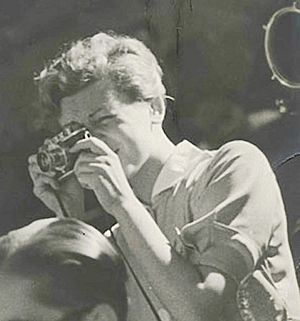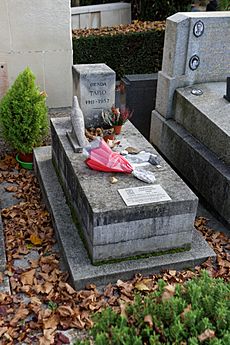Gerda Taro facts for kids
Quick facts for kids
Gerda Taro
|
|
|---|---|

Taro in Spain, July 1937, with Leica camera and 5cm Summar lens
|
|
| Born |
Gerta Pohorylle
1 August 1910 |
| Died | 26 July 1937 (aged 26) |
| Resting place | Cimetière du Père-Lachaise, Paris, France |
| Years active | 1935–1937 |
| Employer | Alliance Photo |
| Partner(s) | Robert Capa (1935–1937) |
| Parents |
|
Gerda Taro (born Gerta Pohorylle; August 1, 1910 – July 26, 1937) was a brave war photographer from Germany. She worked during the Spanish Civil War. Many people see her as the first woman photojournalist to die while reporting from the front lines of a war.
Gerda Taro was also the close friend and work partner of photographer Robert Capa. They were both Jewish. The name "Robert Capa" was actually a made-up name that Taro and Capa (whose real name was Endre Friedmann) shared. They created this name to help them work in Europe, where it was becoming harder for Jewish people to find jobs. It also helped them get more attention in America. Because of this, many early photos credited to Robert Capa were actually taken by Gerda Taro.
Contents
Early Life and Challenges
Gerta Pohorylle was born on August 1, 1910, in Stuttgart, Germany. Her family was Jewish and had recently moved from Eastern Europe. She went to high school and a boarding school, and later studied business.
In 1929, her family moved to Leipzig. This was just before the Nazi Party came to power in Germany. Gerda did not agree with the Nazis and became interested in politics that supported fairness for everyone. In 1933, after the Nazis took control, she was arrested. She had been sharing information against the Nazis. Because of the danger, her family had to leave Germany. Gerda, who was 23, went to Paris. Her parents tried to go to Palestine, and her brothers went to England. She never saw her family again.
A Career in Photography
Gerda Taro's career was short, but she made a big impact on photojournalism, especially in war reporting. She and Robert Capa helped create the style of modern war photography. They showed people what life was like in the middle of a conflict.
Creating the Robert Capa Name
In 1934, Gerda moved to Paris to escape the unfair treatment of Jewish people in Germany. There, she met Endre Friedmann, a Jewish photographer from Hungary. She learned photography from him and became his assistant. They fell in love. Gerda also started working as a picture editor for a company called Alliance Photo.
In 1936, Gerda got her first official photojournalist pass. Then, she and Friedmann came up with a clever idea. Friedmann pretended to be the agent for a photographer named "Robert Capa," a name they had just invented. They both took news photos and sold them as if they were all taken by this made-up American photographer. This helped them get work in a difficult political time and attracted American buyers. The name "Capa" came from Friedmann's nickname in Budapest, "Cápa," which means "Shark."
Their secret didn't last long. Friedmann kept the name "Capa" for himself because it was good for business. Gerda Pohorylle chose her own professional name, "Gerda Taro." She got the idea from Japanese artist Tarō Okamoto and Swedish actress Greta Garbo. They worked together to photograph the political changes in France in the 1930s.
Reporting on the Spanish Civil War
When the Spanish Civil War started in 1936, Gerda Taro traveled to Barcelona, Spain. She went with Capa and David "Chim" Seymour to cover the war. In Spain, people called her La pequeña rubia, which means "The little blonde." They reported on the war in different parts of Spain.
At first, they often worked together under the name "Robert Capa." Their photos were published in important magazines like Zürcher Illustrierte and Vu. You could tell their early photos apart because Gerda used a Rollei camera that took square pictures, while Capa used a Contax or Leica camera for rectangular photos. Later in 1937, they both took similar 35mm pictures under the name "Capa&Taro."
Over time, Gerda became more independent. She turned down Capa's marriage proposal. She also became known among European thinkers and artists who were against fascism and supported the Spanish Republic. A French newspaper, fr:Ce Soir, hired her to publish only her photos. She then started selling her work under the name Photo Taro. Her pictures appeared in magazines like Regards, Life, and Illustrated London News.
Gerda Taro's most famous photos came from her reporting on the Valencia bombing by herself. In July 1937, her photos were in high demand around the world. She was covering the Brunete area near Madrid for Ce Soir. Even though the other side claimed they controlled the area, the Republican forces had actually pushed them out. Gerda's photos were the only proof of what was really happening.
Gerda Taro's Death

During her reporting on the Republican army's retreat at the Battle of Brunete, Gerda Taro jumped onto the side of General Walter's car. The car was carrying wounded soldiers. Suddenly, a Republican tank crashed into the car. Gerda was badly hurt and died the next day, on July 26, 1937.
There have been some questions about how Gerda died. However, a nephew of a Republican soldier who was at the Battle of Brunete explained that she died in an accident. He said she was run over by a tank that was backing up. She died from her injuries a few hours later in an English hospital. The tank driver did not realize what had happened.
Because of her strong beliefs, Gerda Taro became a respected symbol against fascism. On August 1, 1937, which would have been her 27th birthday, the French Communist Party held a huge funeral for her in Paris. Tens of thousands of people came out. She was buried at Père Lachaise Cemetery. A famous artist, Alberto Giacometti, was asked to create a monument for her grave.
In early 2018, a photo believed to be of Gerda Taro on her deathbed in the hospital was shared by the son of the doctor who treated her.
Her Lasting Legacy
On September 26, 2007, the International Center of Photography held the first big U.S. exhibition of Gerda Taro's photos.
In October 2008, the city of Stuttgart named a square after her: the Gerda-Taro-Platz. The square was updated in 2014 with nine metal pillars, each with a letter of her name cut out.
In the summer of 2016, an outdoor display of Gerda Taro's Spanish Civil War photos was part of a photography festival in Leipzig. It was decided the display would become permanent. However, on August 4, the display was damaged with black paint. A project to fix the damage is ongoing, and the damaged display remains in place.
The book Waiting for Robert Capa by Susana Fortes (2011) is a story based on the lives of Taro and Capa.
The documentary film The Mexican Suitcase (2011) tells the story of a lost suitcase. It contained 4,500 photo negatives taken by Taro, Capa, and David Seymour during the Spanish Civil War. The suitcase and its negatives are now at the International Center of Photography in New York City. When these photos were sorted, many that were once thought to be Capa's were found to be Taro's. This helped people understand her important role in photojournalism.
The British band alt-J has a song called "Taro" about her role as a war photographer and her relationship with Capa.
In 2017, the City Council of Madrid decided to name a street in the city "Calle Gerda Taro" (Gerda Taro Street). The city of Paris did the same in 2019, naming a new street "Rue Gerda Taro."
In 2018, the city of Leipzig named a new high school for 1,200 students after Gerda Taro. It is near the permanent display of her photographs.
She was featured on Google's Doodle on August 1, 2018.
In 2017, she was the main character in the novel The Girl with the Leica by Helena Janeczek.
In 2022, an exhibition at the International Center of Photography showed new details about Gerda Taro's contributions to Robert Capa's photo book, "Death in the Making."
In 2023, she was the subject of the novel in verse, One Last Shot, by Kip Wilson.
Exhibitions
- Death in the Making: Reexamining the Iconic Spanish Civil War Photobook, September 29, 2022-January 9, 2023, International Center of Photography, New York, NY.
Images for kids
-
Taro's grave at Père Lachaise Cemetery. Designed by Alberto Giacometti, it features the falcon Horus, and the epitaph "So nobody will forget your unconditional struggle for a better world" (in French and Catalan)
See also
 In Spanish: Gerda Taro para niños
In Spanish: Gerda Taro para niños


